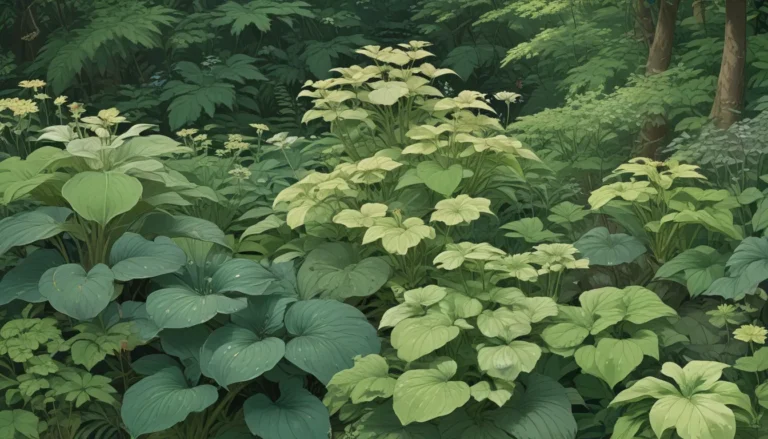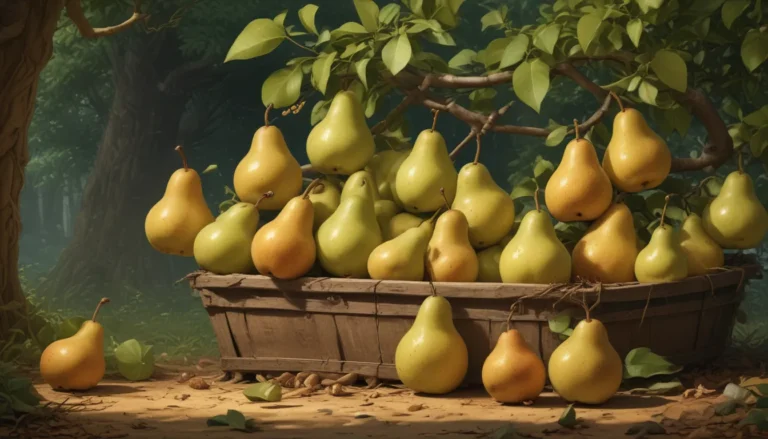The Ultimate Guide to Growing and Caring for ‘Bartlett’ Pear Trees

When it comes to juicy and mouth-watering pears, you can’t go wrong with ‘Bartlett’ pears. These delightful fruits consistently top the lists of the best pears, thanks to their delicious taste, sweet aroma, and smooth texture. Add in their beautiful colors that lighten with ripeness, it’s no wonder ‘Bartlett’ pears are a favorite for many.
But growing your own ‘Bartlett’ pear tree requires some knowledge and care. In this extensive guide, we’ll cover everything you need to know to successfully cultivate and maintain these fantastic trees. From the history of ‘Bartlett’ pears to the best practices for propagation, care, and pest management, we’ve got you covered.
So, grab your gardening gloves and let’s dive into the wonderful world of ‘Bartlett’ pear trees!
What Are Bartlett Pear Trees?
The ‘Bartlett’ pear, also known as ‘Williams,’ is a cultivar of Pyrus communis, the European or common pear. With its oval to pyramidal form and glossy dark green leaves that turn yellow in the fall, ‘Bartlett’ trees are not just fruit bearers but also aesthetic delights.
These trees bloom with beautiful white flowers in early spring, followed by the formation of green or dark red pears in summer, ready for harvest in the fall. The green fruits turn golden yellow when ripe, while the dark red ones take on a lighter shade of red. And if well cared for, ‘Bartlett’ trees can continue to produce fruit for over a century!
Cultivation and History
The story of the ‘Bartlett’ pear began with an English schoolmaster named John Stair in the late 1700s. After discovering the tree growing wild in England, Stair propagated cuttings leading to its commercialization by a nurseryman named Williams. The tree made its way to the United States in the 1790s, where it was introduced by Thomas Brewer and later popularized by Enoch Bartlett.
Despite early confusion with the ‘Williams’ cultivar, ‘Bartlett’ pears became widely known and sought after, eventually earning a permanent place in American fruit culture.
Bartlett Pear Tree Propagation
While you could attempt to grow ‘Bartlett’ pear trees from seeds, grafting or budding from existing trees is a more reliable and efficient method. Nurseries use these techniques to ensure the offspring retains the desirable traits of the parent plant.
For home gardeners, stem cutting propagation or transplanting nursery specimens are recommended methods for growing ‘Bartlett’ pear trees. Stem cuttings should be taken in late spring or midsummer and require proper care and attention to ensure successful root formation.
Transplanting involves carefully planting nursery specimens in ideal soil conditions with necessary spacing for optimal growth. Both methods offer viable ways to propagate ‘Bartlett’ pear trees and establish healthy, productive orchards.
From Stem Cuttings
- Take cuttings from existing ‘Bartlett’ specimens in late spring or midsummer.
- Propagate the cuttings with rooting hormone and careful attention to lighting and temperature conditions.
- Transplant rooted cuttings into individual pots and gradually acclimate them to outdoor conditions.
Via Transplanting
- Choose bare root or containerized nursery specimens for planting.
- Ensure proper soil preparation and watering to establish transplants successfully.
- Monitor soil moisture and provide necessary support for tree growth and development.
How to Grow Bartlett Pear Trees
To achieve successful fruit production, ‘Bartlett’ pear trees require specific climate, soil, and care conditions. From adequate sunlight and well-draining soil to regular watering and pruning, a few key considerations can help your trees thrive and bear delicious fruit.
Climate and Exposure Needs
Plant ‘Bartlett’ trees in USDA Hardiness Zones 5 to 7 and provide them with full sun exposure for optimal fruiting. Additionally, ensure they receive sufficient chill hours to break dormancy at the right time for healthy growth and development.
Soil Needs
Plant ‘Bartlett’ trees in deep, fertile, and well-draining soil with a pH of 6.0 to 7.0 for optimal nutrient uptake and growth. Regular soil amendments with compost or manure can help maintain soil fertility and support tree health.
Water Needs
After establishing trees, water deeply when the top six inches of soil are dry to ensure proper hydration and nutrient absorption. Monitor soil moisture levels and adjust watering frequency as needed to support tree growth and fruit production.
Growing Tips
- Plant ‘Bartlett’ trees in full sun for maximum fruit production.
- Amend soil regularly with organic matter to maintain fertility.
- Water deeply when the top soil is dry to support tree health and growth.
Pruning and Maintenance
Regular pruning is essential to maintain tree health and shape, remove dead or damaged branches, and promote proper fruiting. Routine maintenance tasks such as removing root suckers, mulching, and weed control can help protect and support tree growth throughout the year.
To prevent pests and diseases, maintain proper hygiene practices by removing fallen leaves and fruits, and monitor for signs of infestation regularly. Implementing preventative measures such as spraying with beneficial bacteria and fungicides can help control common pests and diseases that affect ‘Bartlett’ pear trees.
Where to Buy Bartlett Pear Trees
Whether you’re shopping online or visiting a local nursery, purchasing ‘Bartlett’ pear trees is easier than ever. Many reputable nurseries offer a variety of ‘Bartlett’ cultivars in different sizes and colors to suit your preferences and growing conditions. Online reviews and ratings can help you make informed buying decisions and ensure you receive healthy, high-quality trees for your orchard.
Managing Pests and Disease
Keeping pests and diseases at bay is essential for maintaining healthy ‘Bartlett’ pear trees and ensuring a bountiful harvest. Implementing integrated pest management strategies, such as using physical barriers, beneficial insects, and chemical treatments, can help control common pests like aphids, mites, and scale, as well as diseases such as fire blight and leaf spot.
Herbivores
- Protect trees from deer, squirrels, rabbits, and voles with physical barriers and tree wraps.
- Install hardware cloth to deter burrowing and feeding by herbivores and maintain healthy tree growth.
Insects
- Control insect infestations with commercial sprays, insecticidal soaps, and beneficial bugs.
- Monitor for common pests like codling moths and pear psylla and treat infestations promptly to prevent crop damage.
Disease
- Prune infected tissue and dispose of properly to prevent the spread of diseases like fire blight and leaf spot.
- Consider preventive treatments with fungicides and beneficial bacteria to protect trees from common diseases and maintain overall tree health.
Harvesting, Storing, and Ripening Bartlett Pears
Once your ‘Bartlett’ pear trees start bearing fruit, it’s time to harvest, store, and ripen the delicious pears for consumption. Harvest ripe fruits when they reach maturity and firmness, and allow them to ripen at room temperature for optimal flavor and texture.
Store harvested pears in the refrigerator to extend their shelf life, and check them regularly for ripeness. Once ready, enjoy fresh ‘Bartlett’ pears on their own or incorporate them into a variety of culinary dishes.
Recipes and Cooking Ideas
Whether eaten fresh, preserved, or used in savory and sweet recipes, ‘Bartlett’ pears are a versatile fruit that can elevate any dish. From salads and desserts to preserves and syrups, the sweet and juicy flavor of ‘Bartlett’ pears adds a delightful touch to any meal. Experiment with different cooking ideas and recipes to discover the endless culinary possibilities of these delectable pears.
Conclusion
In conclusion, growing and caring for ‘Bartlett’ pear trees requires dedication, knowledge, and a little love. By following the guidelines outlined in this comprehensive guide, you can cultivate healthy, productive trees that bear delicious fruit year after year. From pruning and pest management to harvesting and cooking, ‘Bartlett’ pear trees offer a rewarding and flavorful experience for any gardener. So, roll up your sleeves and start growing your own ‘Bartlett’ pear orchard today!
If you have any questions, comments, or recipe suggestions, feel free to share them in the comments section below. Happy gardening and happy pear growing!
Additional Resources
- 11 of the Best Fruiting Pear Varieties to Grow at Home
- 9 of the Best Asian Pear Varieties for the Home Garden
- 13 of the Best Winter Pear Varieties to Grow at Home
Remember, a pear orchard is not just a collection of trees but a labor of love and dedication. With the right knowledge and care, your ‘Bartlett’ pear trees can thrive and provide you with a bountiful harvest for years to come. Enjoy the sweet taste of success with your very own pear orchard!





